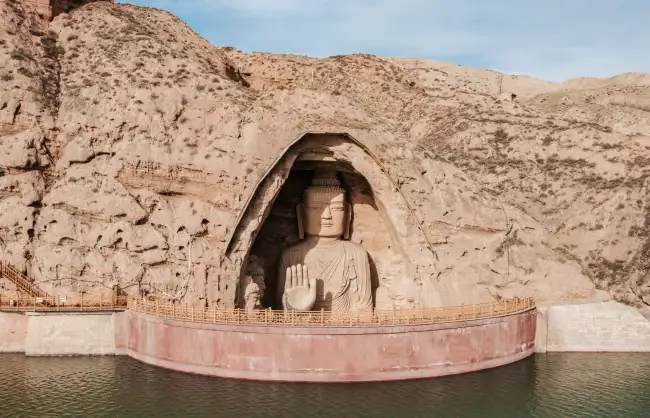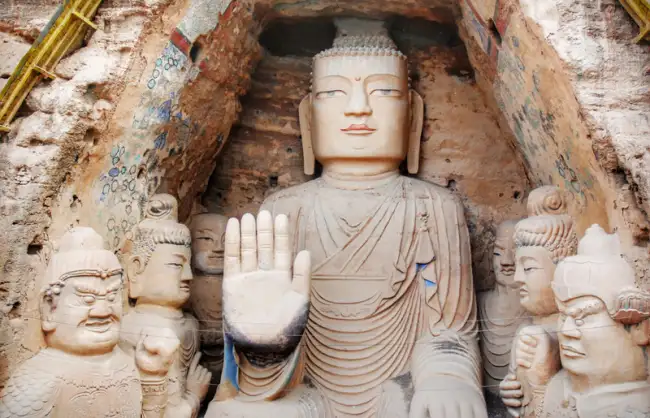Tiantishan Grottoes, also called the Big Buddha (Dafo) Temple, are the earliest grottoes built in China. They were built during East Jin and the 16 Kingdoms Period, over 1,600 years ago, in today’s Gansu Province. They are named Tiantishan, meaning sky ladder mountain, because the narrow stone path leading up to the peaks looks like a ladder hanging from the sky.
The grottoes of Tiantishan were built by various artists from North Wei, Sui, Tang, West Xia dynasties all together. It became a lama temple during Ming and Qing dynasties. The grottoes have been damaged a number of times during earthquakes throughout history, because the earth in the area is especially soft.
For the sake of preservation and research, part of the sculptures and paintings from Tiantishan Grottoes were relocated to Gansu Provincial Museum and some of the inscriptions and silk paintings to Dunhuang Cultural Relic Research Center.
Tiantishan Grottoes are a significant landmark along the Silk Road. They have attracted countless visitors to make the pilgrimage during their Gansu tour. When you visit, you’ll see 3 layers of grottoes with 17 shrines and over 100 statues of Buddha.
Fast Facts about Tiantishan Grottoes
- Location: Dengshan Village of Zhonglu Town, 31 miles (50 kilometers) south of Wuwei City, Gansu Province
- Hours: 9:00 am to 5:00 pm
- Ticket price: free for entry, but you need to pay CNY 10 yuan to enter the nearby Faxi Temple
- Visit time: about an hour
- Best time to visit: spring or autumn
- Suited to: anyone interested in Buddhism, history, art

What to See and Do at Tiantishan Grottoes
1. See the 15-meter-high statue of Sakyamuni Buddha
The grotto that houses this 49-feet tall, massive statue of Buddha is the biggest grotto, with a height of 98 feet (30 meters). The statue is placed in a large open space. The outstretched hand of Buddha reaches out from the cliff wall. Walk about the massive crescent-shaped dam. You’ll definitely be amazed when you see the statue at Tiantishan Grottoes in person.
2. Explore the 17 caves that contain various sculptures and paintings
Explore the 17 caves with sculptures and murals depicting Buddhist figures and scenes, including symbolic elements like tigers, black dragons, a spotted deer, an elephant, a white horse, and the iconic tree of Buddha.
3. Visit the nearby Faxi Temple
While you’re at Tiantishan Grottoes, visit the nearby Faxi Temple, or Upper Tianzhu Temple. You’ll find a stupa dedicated to Kumarajiva. On temple grounds are ancient structures, stone carvings, and rare scriptures.
4. Enjoy the natural scenery and the peaceful atmosphere
Taka a minute to appreciate the surrounding view of Tianzhu Mountain from Tiantishan Grottoes. The locals in the mountain region sometimes hold festival celebrations that welcome visitors, like Tianzhu Mountain Tea Festival in April and Tianzhu Mountain Buddhist Culture Festival in October.

Best Time to Visit Tiantishan Grottoes
Wuwei has a continental arid climate with four distinct seasons. It sees its highest temperature usually in July, 22.1°C (71.8°F) on average. And the coldest month is January, with an average temperature of -7.4°C (18.7°F). Spring and autumn are considered the best time to travel to Gansu. During these seasons, the weather is nice, and the natural scenery is at its best.
If you’re keen for cultural landscapes of the Silk Road, keep these dates in mind. Liangzhou Cultural Tourism Festival is held usually in September/October, Wuwei International Kite Festival in April/May, and Wuwei Grape Festival in August/September.
How to Get to Tiantishan Grottoes
By bus: To reach Tiantishan Grottoes from Wuwei City, take a long-distance bus to Dengshan Village in Zhonglu County. It’s about 31 miles (50 kilometers) south of Wuwei. The bus ride costs CNY 10 and takes about an hour. From Dengshan Village, Tiantishan Grottoes is only a 1.2-mile (2-kilometer) walk away.
By taxi: A round trip between Tiantishan Grottoes and Wuwei City by taxi costs around CNY 200. The drive takes about 40 minutes. It is the easiest and most efficient way.
Attractions nearby Tiantishan Grottoes
Changchengxiang Great Wall is about 25 miles (40 kilometers) away from Tiantishan Grottoes. It’s a great place for a hike with stunning countryside views near the village of Changchengxiang.
Wuwei Confucius Temple is about 31 miles (50 kilometers) from the grottoes. It is the largest and best-preserved Confucius temple in Gansu Province. You’ll see notable buildings, steles, and scriptures, including the renowned Western Xia Tablet.
Kumarajiva Pagoda is 31 miles (50 kilometers) from the grottoes. It is a 108-foot (33-meter) tall octagonal brick structure within Kumaraji Temple, housing the stupa of Kumarajiva. It has an amazing history dating back to the 5th century.
China Silk Road Tours to Tiantishan Grottoes
- 5 Days Hexi Corridor Silk Road Tour of Lanzhou-Wuwei-Zhangye
- 13 Days Silk Road Tour from Xining to Urumqi









